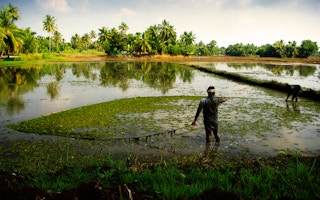One of the most important discussions around the new Sustainable Development Goals (SDGs) is who is going to foot the bill, and for what. Global leaders will meet in Addis Ababa later this year to discuss exactly that, and chart the way forward for mobilizing the financial and technical resources needed to make these ambitious goals a reality.
To continue reading, subscribe to Eco‑Business.
There's something for everyone. We offer a range of subscription plans.
- Access our stories and receive our Insights Weekly newsletter with the free EB Member plan.
- Unlock unlimited access to our content and archive with EB Circle.
- Publish your content with EB Premium.
I am at the United Nations in New York this week, to make sure that farmers are not forgotten in this discussion. Current plans have gaps that need to be urgently addressed: namely targeting investments to get science and innovation into farmers’ hands.
Agriculture is critical to many
The good news is that the draft outcome document for this Third International Conference on Financing for Development does believe that investing in agriculture will have what it calls “rich payoffs” across the SDGs, not just those relating to hunger. Indeed, there are not many of the proposed SDGs that do not impact, or will not be impacted by agriculture.
Sustainable water management for example, is a hot topic in both developed and developing countries alike. And we stand no hope of improving water management without addressing the sector that accounts for almost 60 per cent of global freshwater withdrawals, which is agriculture. Similarly, in relation to climate change, agriculture accounts for around 30 per cent of greenhouse gas emissions (when paired alongside deforestation) and is also most vulnerable to its impacts, yet the sector also carries huge capacities to mitigate greenhouse gas emissions through sustainable farming practices.
Agriculture also happens to be the main occupation of millions of women all over the world who produce a vast proportion of our food. So supporting them to grow their businesses is going to be an important step towards gender equality, another key area the SDGs seek to tackle.
Ensure farmers can access tools needed
“
Sustainable water management for example, is a hot topic in both developed and developing countries alike. And we stand no hope of improving water management without addressing the sector that accounts for almost 60 per cent of global freshwater withdrawals, which is agriculture.
While the current draft outcome document commits to substantially increase public investment in rural infrastructure and agricultural research – which will undoubtedly contribute to the three focus areas mentioned above – I am reminded of a Malawian farmer colleague named Alice Kachere. She was amazed at the technology I had at my disposal to boost my yields and profits. Her one question was: how do I get this on my farm?
The scientific innovations that are discovered thanks to investments in agricultural research will be useless if we are not securing the funding required to get them to farmers like Alice. At a minimum, this requires investment into rural public goods, from transport infrastructure and electrification to education and functioning markets. From here, we need to be investing in successful models that allow vital inputs like drought-resistant seeds or drip irrigation packages to remote rural areas where an estimated 430 million people in the developing world live. This could take the form of helping agrodealers get trained and set up to sell seeds, fertilizer and pest control products to a community. It could take the form of getting warehouses built which can safely store large quantities of inputs, which can then be delivered to a central delivery point for farmers to collect. As our fellow Farming First supporter organisation One Acre Fund says, we need a “distribution revolution”.
Invest in rural extension services
At the same time, farmers need access to these tools and technologies, as well as how to use them. Services that offer advice to farmers, called extension agencies, have seen their funding slashed over recent decades. Both the private sector and NGOs are trying to fill this gap, but an injection of public funding would be hugely beneficial. It is going to be critical if rural farmers are to be empowered to produce more food to meet growing food demands.
It is clear that agriculture is the common thread which holds together the Sustainable Development Goals. Investing in agriculture is therefore one of the most effective routes to tackling not only hunger and malnutrition but also other key challenges.
Sue Carlson is Chair of the World Farmers Organisation’s Women’s Committee and a spokesperson for the agricultural coalition Farming First. This article is republished from Thomson Reuters Foundation.










